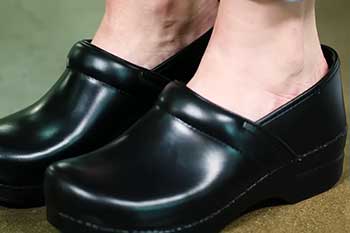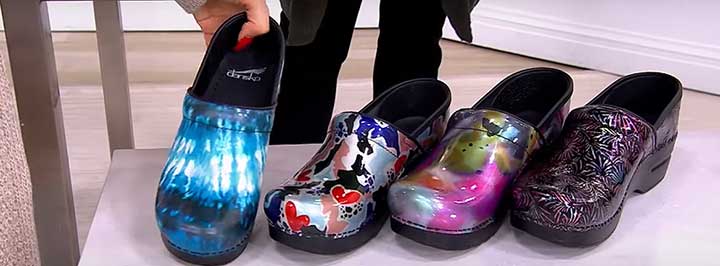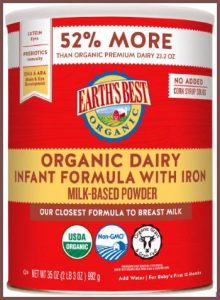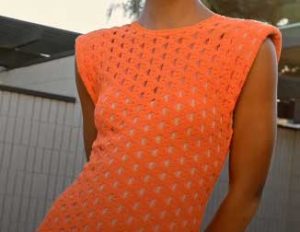Clogs have become a popular footwear choice for their comfort and support. Two of the biggest names in clogs are Dansko and Birkenstock. But with so many styles to pick from, how do you decide which brand is right for you?
In this comprehensive guide, we’ll compare every aspect of Dansko and Birkenstock clogs. We’ll examine their key features, benefits, disadvantages, and styles so you can determine the best option for your needs.
A Brief Comparison Table
| Feature | Dansko | Birkenstock |
| Comfort Style | Roomy toe box, cushioned insole, shock-absorbing outsole | Contoured cork footbed molds to feet |
| Support | Arch support from molded footbed | Custom arch support from molded cork |
| Style Variety | Lots of clogs and sneakers for workplaces | Minimalist sandals and clogs for casual wear |
| Sizing | Runs large and wide | Runs slightly large and narrow |
| Break-in Period | Stiff wooden base takes time to soften | Cork molds to feet over time |
| Price Range | $100 – $150 | $135 – $175 |
| Weight | Heavier and substantial | Lightweight and flexible |
| Wet Conditions | Water resistant oiled leather/PU sole | Suede and cork absorb moisture |
An Overview of Dansko and Birkenstock
First, let’s introduce each brand and their history:
- About Dansko

Dansko was founded in 1990 by husband and wife team Peter Kjellerup and Mandy Cabot.
Based in Pennsylvania, Dansko designs comfortable clogs and shoes for workplace environments like healthcare, hospitality, and food service.
Dansko believes high quality footwear should provide shock absorption and arch support to reduce foot fatigue.
Their signature clog has a roomy toe box, padded instep, and lightweight rocker bottom sole. The natural arch and toe bar promote stability.
Dansko clogs have become the footwear of choice for people who spend long hours on their feet like nurses and chefs. Beyond clogs, Dansko also makes sandals, heels, boots, and sneakers. They use high quality leather from Europe for many styles.
- About Birkenstock
Birkenstock is a German company that dates back to 1774, when Johann Adam Birkenstock first made shoes with contoured soles. Based in Neustadt, Germany, Birkenstock is now run by the sixth generation of the founding family.
Birkenstock rose to popularity in the 1960s and 70s among hippies who loved the comfortable, natural shoes. The contoured sole mirrored the shape of the foot and shifted weight to different areas for better distribution. As the cork footbed molded to the feet, it provided customized arch support.
In addition to the classic Arizona sandal, Birkenstock makes slip-ons, clogs, and other shoes featuring their signature footbed. They promote health benefits like improved posture and circulation.
Now that we’ve introduced both brands, let’s compare them in depth across the following categories:
Comfort and Support Comparison of Dansko And Birkenstock Clogs
Comfort is the number one priority for both Dansko and Birkenstock shoes. But they provide it through slightly different approaches:
Dansko Comfort Features
- Roomy toe box allows toes to spread out naturally
- Contoured footbed supports arches
- Padded instep prevents rubbing
- Shock-absorbing PU or rubber outsole
- Rocker bottom enables natural walking motion
- Anti-fatigue construction for long wear
Dansko’s clogs are designed to be worn for extended periods, whether you’re on your feet all day at work or out exploring. Reviewers praise their instant comfort and lack of break-in period.
Birkenstock Comfort Features

- Molded cork footbed conforms to unique foot shape
- Custom arch and toe grip support
- Deep heel cup keeps feet in place
- Flexible sole allows feet to move naturally
- Moisture-wicking suede footbed
- Massaging bumps and ripples on footbed
Birkenstock’s contoured footbed is the key to their comfort.
As the cork molds specifically to your foot, it provides customized arch and heel support.
The materials make them lightweight and breathable.
However, the break-in period is longer than Dansko.
Both brands excel at comfort through support and cushioning. Dansko has instant softness, while Birkenstock takes time to feel like a custom fit.
Style Variety
Dansko and Birkenstock take different approaches when it comes to style:
Dansko Style Selection
- Clogs in leather, patent leather, and fabric
- Slip-on, lace-up, buckle, and mary jane clogs
- Mules, sandals, boots, sneakers also available
- Lots of styles appropriate for workplace
- Classic colors like black and brown
Dansko focuses mainly on clogs but has a wide selection to suit various environments, like the hospital or office. You’ll find both open and closed back clogs in materials ranging from dressy patent leather to casual suede. Beyond clogs, they also make sandals, heels, and sneakers.
Birkenstock Style Selection
- Arizona, Boston, and Madrid signature sandals
- Open-back clogs and slip-ons
- Minimalist, earthy style
- Mainly suede, nubuck, and oiled leather
- Limited color options
- Few shoes suitable for workplace
Birkenstock has a narrower range of styles, concentrated in sandals and clogs featuring their contoured footbed. Choices are limited to mostly neutral, natural colors. The shoes have an informal, hippie chic aesthetic. There aren’t many options appropriate for wearing to the office.
For variety of styles, especially in a professional context, Dansko is the winner. But Birkenstock offers classic comfort styles with timeless appeal.
Sizing and Break-In Period
Breaking in new clogs is a key considertion for comfort. Here’s how sizing and break-in periods compare:
Dansko Sizing and Break-In

- Runs large (at least 1/2 size)
- Order wide width if you have wide feet
- Little to no break-in period required
- Leather uppers soften quickly
- Outsoles flexible right away
Dansko clogs are known for providing comfort right out of the box, without an uncomfortable break-in process.
The footbeds are soft, and the leather uppers don’t require prolonged wear to soften up.
You’ll have the full Dansko comfort experience as soon as you try them. However, the sizing does run large and wide.
Birkenstock Sizing and Break-In
- Runs slightly large
- Narrow fit
- 4-6 week break-in period
- Cork footbed molds to your feet over time
- Stiff soles soften up with wear
- Suede uppers conform to feet
Due to the molded cork footbed, Birkenstocks require more time to break-in and feel customized to your feet. Expect at least a month of regular wear as the footbed shapes to your foot contours.
Birkenstock does recommend wearing them with socks at first to absorb moisture. The cork and suede gradually conforms to create a personalized fit.
For instant comfort with no break-in struggles, Dansko is the winner. But if you don’t mind a gradual process, Birkenstocks reward your patience.
Cost Comparison
Now let’s compare the price points of these high-quality clog brands:
Dansko Clog Pricing
- Signature clogs $120-$150
- Workplace-style clogs $100-$140
- Heels and boots around $170
- Sandals and sneakers $80-$130
Dansko clogs cost from $100 for basic styles up to $150 for leather and suede varieties. Given their comfort features and premium materials like European leather, this represents a solid value for the cost. More specialty styles like boots and heels run up to $170.
Birkenstock Clog Pricing
- Arizona sandals $135-$155
- Boston and London clogs $140-$175
- Specialty clog styles up to $200+
- Kids and baby styles around $60
- Sale or “basic” styles from $100
Birkenstocks are priced higher than Dansko, ranging from $135 into the $200s. Their premium cork footbed does justify the price to an extent. However, many customers find Dansko’s features and quality comparable or better at a lower cost. Birkenstock does offer children’s styles for less.
Based on typical retail prices, Dansko provides better value at 10-30% less than Birkenstock. But both brands produce quality clogs with the potential to last for years.
Also Read: Comparison of NAOT And Birkenstock Clogs.
Weight Comparison

The weight of clogs affects their wearability for long periods. Here is how Dansko and Birkenstock compare:
Dansko Clog Weight
- Wooden platform base and outsole
- Chunky, substantial feel
- Heavier than average shoe due to wood
- Not ideal for extended wear or travel
A thick wooden base gives Dansko clogs their signature appearance. But it does add noticeable weight. The wood platform, padded insole, and thick outsole result in a heavier shoe. While fine for short periods, the weight makes them less suited for all-day wear. They can also be clunky for travel.
Birkenstock Clog Weight
- Lightweight cork footbed
- Flexible rubber sole
- Open back styles are feather light
- Great for long wear and travel
- Average 10-12 oz per shoe
Thanks to the minimalist cork and rubber composition, Birkenstock clogs have a light, flexible feel. Even closed back styles maintain an airy, lightweight quality that makes them ideal for prolonged wear. The shoes weigh an average of 10-12 ounces, great for packing on trips.
If you want truly lightweight clogs, Birkenstock is the clear winner. Dansko’s wood sole has its benefits, but does weigh the shoes down.
Wet Condition Performance
Clogs hold up better to some weather conditions than others. Here’s how they compare:
Dansko in Wet Conditions
- Leather uppers resist moisture
- Sealed seams prevent leaks
- PU or rubber outsoles don’t absorb water
- Can be worn in light rain or snow
- Withstand spills and stains at work
Thanks to leather uppers and waterproof soles, Dansko clogs stand up well to wet conditions. Nurses and restaurant workers praise their ability to resist spills, snow, and rain during work shifts. They provide good traction even when floors are wet.
Birkenstock in Wet Conditions
- Suede and cork absorb moisture
- Can develop odors if soaked
- Not recommended for rain, snow
- Rubber sole provides some traction
Birkenstock’s suede uppers and cork footbed absorb water readily. Extended exposure to rain or snow will soak the shoes through. The materials are also prone to developing odors if allowed to stay wet. Birkenstock doesn’t recommend wearing their sandals and clogs in very wet conditions.
For handling wet weather or work environments, Dansko is the obvious winner. Birkenstock’s porous materials just aren’t suited for moisture resistance.
Also Read: Differences Between Calzuro And Crocs.
Appearance Over Time
Here’s how the clogs compare in durability and long-term appearance:
Dansko Appearance Over Time
- Leather scuffs but polishes up
- Replaceable footbed and outsole
- Soling services can recondition
- With care, lasts over 5 years
- Develops patina with age
Dansko’s leather uppers develop scuffs and stains but can be polished to look like new. The footbed and sole can be replaced when worn down. With proper care and periodic resoling, Dansko clogs often last over 5 years with heavy daily wear. The leather develops an attractive patina over time.
Birkenstock Appearance Over Time

- Suede wears smooth, stains possible
- Cork footbed molds permanently
- Glue and seams may deteriorate
- With care, lasts 4-6 years
- Develops personalized molding
Birkenstock’s cork and suede blend conform to your feet, which means they won’t rebound if you stop wearing them.
Seams and glue can deteriorate after several years.
With proper maintenance, Birkenstock advises a typical lifespan of 4-6 years for regular wear. The customized molding can’t be replicated in a replacement pair.
For longevity and reconditioning ability, Dansko has a slight edge. But Birkenstock’s molded fit has benefits too, if you continue replacing the same style.
Environmentally Friendly Practices
Eco-conscious production is important to both companies:
Dansko’s Green Practices
- Leather sourced from Environmentally Preferred Suppliers
- Evaluates environmental impacts of materials
- Supports initiatives like Clean Air Council
- Uses natural materials like wool, cork, and latex
- Avoids PVC in production when possible
While leather tanning does have environmental impacts, Dansko aims to source its leather responsibly. The company actively works to reduce hazards and waste in production. They support environmental organizations focused on promoting clean air and soil quality.
Birkenstock’s Green Practices
- Uses natural cork and latex materials
- Recycles shoe components after use
- Achieved climate neutral certification in 2020
- Uses renewable energy in production facilities
- Print catalogs on recycled paper with eco-inks
Birkenstock’s most environmentally friendly choice is their reliance on natural materials like renewable cork. They’ve made investments to achieve climate neutral operations through clean energy. The company has a recycling program to cut down on waste from old sandals and clogs.
Overall, both brands aim to be environmentally responsible. Birkenstock may have an edge by using more natural materials in shoe construction.
Also Read: Differences Between Calzuro And Dansko Clogs.
Frequently Asked Questions (FAQ)
Still trying to decide between Dansko and Birkenstock? Here are answers to some common questions:
Yes, many podiatrists recommend Birkenstocks to treat plantar fasciitis. The contoured cork footbed provides customized arch support that distributes weight away from the plantar fascia tissue. Dansko clogs do also provide good arch support, but Birkenstock’s molded fit targets the issue more directly.
Birkenstock does not recommend resoling their sandals and clogs. The cork footbed forms specifically to your feet, so replacing the sole would impact comfort and function. Dansko clogs can be resoled because their footbed isn’t customized.
Yes, Dansko offers most of their clog styles in narrow, medium, and wide widths. Their sizes tend to run large, so sizing down and choosing a width is key for the right fit. Birkenstock sandals and clogs only come in medium/standard width.
Yes, Dansko clogs are highly recommended for nurses and medical workers who are on their feet all day. The shock absorption and arch support help reduce foot pain and fatigue. The roomy toe box accommodates swelling. styles with a closed back provide more spills protection.
The Verdict: Which Clog Brand Is Better?
In the battle of Dansko and Birkenstock, there’s no universally “better” option. The right clog depends on your personal needs and preferences:
Dansko is ideal if you want:
- Instant comfort with no break-in
- Roomy toe box
- Variety of workplace-ready styles
- Better for wet conditions
- Affordable price point
Birkenstock is better if you prefer:
- Custom-molded cork footbed
- Casual, minimalist styles
- Very lightweight feel
- Environmentally friendly materials
- Patience for break-in period
Both brands offer excellent comfort and quality construction. Dansko gives you instant softness right out of the box, while Birkenstock rewards you after a gradual break-in.
There are also minor differences, like Dansko’s suitability for wet conditions or Birkenstock’s light weight. Consider how you plan to use your clogs and your budget to pick the pair that’s perfect for you! With either brand, you can be confident you’re investing in incredible support for all-day wear.



